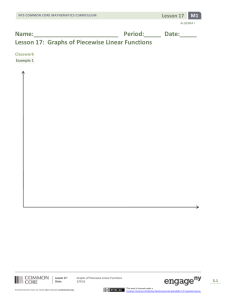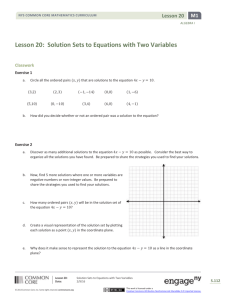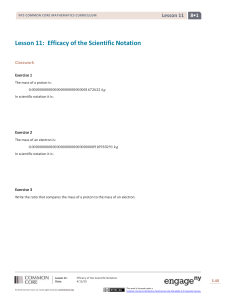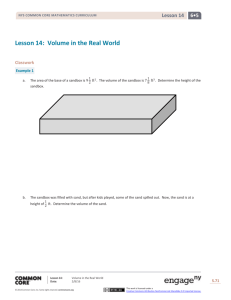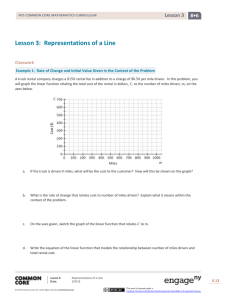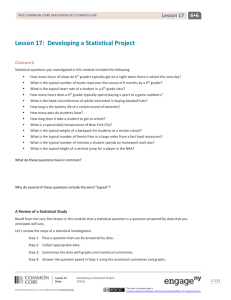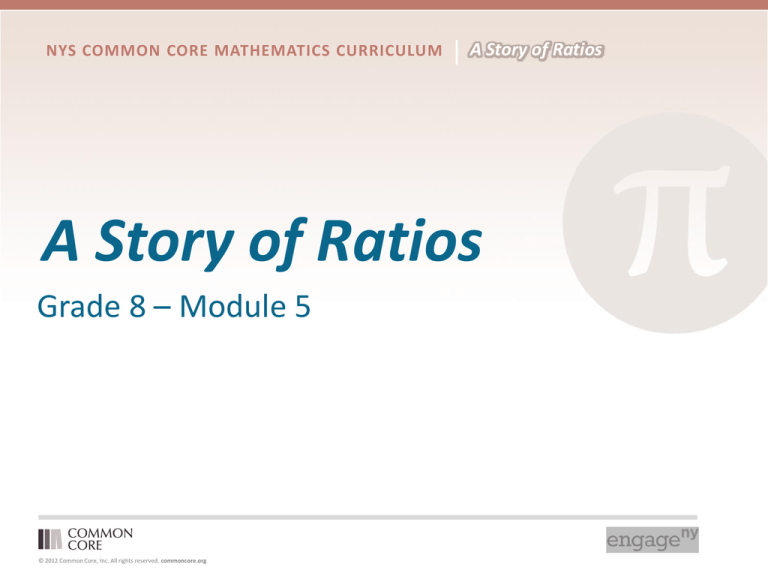
NYS COMMON CORE MATHEMATICS CURRICULUM
A Story of Ratios
A Story of Ratios
Grade 8 – Module 5
© 2012 Common Core, Inc. All rights reserved. commoncore.org
NYS COMMON CORE MATHEMATICS CURRICULUM
A Story of Ratios
Session Objectives
• Examination of the development of mathematical
understanding across the module using a focus on
Concept Development within the lessons.
• Introduction to mathematical models and
instructional strategies to support implementation of
A Story of Ratios.
© 2012 Common Core, Inc. All rights reserved. commoncore.org
NYS COMMON CORE MATHEMATICS CURRICULUM
Agenda
Introduction to the Module
Concept Development
Module Review
© 2012 Common Core, Inc. All rights reserved. commoncore.org
A Story of Ratios
NYS COMMON CORE MATHEMATICS CURRICULUM
A Story of Ratios
Curriculum Overview of A Story of Ratios
© 2012 Common Core, Inc. All rights reserved. commoncore.org
NYS COMMON CORE MATHEMATICS CURRICULUM
Module 5 Overview
•
•
•
•
•
•
•
•
Table of Contents
Overview
Focus Standards
Foundational Standards
Focus Standards for Mathematical Practice
Terminology
Tools
Assessment Summary
© 2012 Common Core, Inc. All rights reserved. commoncore.org
A Story of Ratios
NYS COMMON CORE MATHEMATICS CURRICULUM
Agenda
Introduction to the Module
Concept Development
Module Review
© 2012 Common Core, Inc. All rights reserved. commoncore.org
A Story of Ratios
NYS COMMON CORE MATHEMATICS CURRICULUM
Topic A: Functions
• Function is introduced conceptually, then defined
formally
• Functions are useful in making predictions
• Discrete and continuous rates
• The graph of a function is identical to the graph of
the equation that describes it
• A constant rate of change implies a linear function
and rates can be used for comparison of functions
• Graphs of non-linear functions
© 2012 Common Core, Inc. All rights reserved. commoncore.org
A Story of Ratios
NYS COMMON CORE MATHEMATICS CURRICULUM
L1: The Concept of a Function
• Are functions just like linear equations?
• What predictions do functions allow us to make?
Lesson 1, Concept Development
© 2012 Common Core, Inc. All rights reserved. commoncore.org
A Story of Ratios
NYS COMMON CORE MATHEMATICS CURRICULUM
Example 1
Work on the handout, write equation on white board.
© 2012 Common Core, Inc. All rights reserved. commoncore.org
A Story of Ratios
NYS COMMON CORE MATHEMATICS CURRICULUM
A Story of Ratios
Example 1
• What predictions can we make?
• Complete the table.
• What is the average speed of the object from zero to three seconds?
© 2012 Common Core, Inc. All rights reserved. commoncore.org
NYS COMMON CORE MATHEMATICS CURRICULUM
A Story of Ratios
Example 2
Discuss in groups, make notes on the handout.
• If this situation is linear, then the answer is no different than that of
Example 1. The stone will drop 192 feet in either interval of 3
seconds.
© 2012 Common Core, Inc. All rights reserved. commoncore.org
NYS COMMON CORE MATHEMATICS CURRICULUM
Example 2
• Shown is actual
data about the
distance traveled
by the stone.
• How many feet did
the stone drop in 3
seconds?
• How does your
answer compare to
that in Example 1?
• Complete the
table.
© 2012 Common Core, Inc. All rights reserved. commoncore.org
A Story of Ratios
NYS COMMON CORE MATHEMATICS CURRICULUM
A Story of Ratios
Example 2
• Use the space in your handout to make a new prediction. How many
feet will the stone drop in 3.5 seconds?
• How reasonable are these answers?
• Is this a reliable method for making a prediction about the number of
feet the stone drops for a given number of seconds?
© 2012 Common Core, Inc. All rights reserved. commoncore.org
NYS COMMON CORE MATHEMATICS CURRICULUM
A Story of Ratios
Example 2
• There is an infinite amount of data that we could gather about the
falling stone. Consider all of the possible time intervals from 0 to 4
seconds!
• Compare the average speed in each interval of 0.5 seconds (Exercise
5):
• The average speed is not equal to the same constant over each time
interval. Therefore, the stone is not falling at a constant speed.
© 2012 Common Core, Inc. All rights reserved. commoncore.org
NYS COMMON CORE MATHEMATICS CURRICULUM
A Story of Ratios
L2: Formal Definition of a Function
• A function assigns to each input exactly one output.
• Students examine tables of values and decide if the
data represents a function or not.
• A function can be described by a rule or formula,
but not every rule will be mathematical. It may be
a description.
• There are limitations to the predictions that can be
made with functions (allusions to domain and
range).
Lesson 2, Concept Development
© 2012 Common Core, Inc. All rights reserved. commoncore.org
NYS COMMON CORE MATHEMATICS CURRICULUM
A Story of Ratios
Opening
• Using the table on the left, how many feet did the object travel in 1
second?
• Using the table on the right, how many feet did the object travel in 1
second?
© 2012 Common Core, Inc. All rights reserved. commoncore.org
NYS COMMON CORE MATHEMATICS CURRICULUM
A Story of Ratios
Discussion
• The table on the left allows for reliable predictions. It allows us to
assign an exact distance for a given time. Therefore, the table on the
left represents data from a function, where the table on the right
does not.
• A function is like a machine:
© 2012 Common Core, Inc. All rights reserved. commoncore.org
NYS COMMON CORE MATHEMATICS CURRICULUM
A Story of Ratios
Discussion
• We can write a mathematical rule to describe the movement of the
falling stone.
• Not all functions can be described this way.
• Consider a function that allows you to predict the correct answers on a test.
It would not be a mathematical rule.
• Functions have limitations. Consider the stone example again. Using
the above rule, can we find a value for distance when t = -2? t = 5?
• Would it make sense in the context of the problem?
© 2012 Common Core, Inc. All rights reserved. commoncore.org
NYS COMMON CORE MATHEMATICS CURRICULUM
A Story of Ratios
L3: Linear Functions and Proportionality
• Linear functions are related to constant speed and
proportional relationships.
• Students use the language related to a function:
• Distance traveled is a function of the time spent traveling.
Lesson 3, Concept Development
© 2012 Common Core, Inc. All rights reserved. commoncore.org
NYS COMMON CORE MATHEMATICS CURRICULUM
A Story of Ratios
Example 1 (PS #7 from L2)
• Do you think this a linear function? Explain.
• The rate of change is the same for any number of bags purchased.
This relationship can be described by y = 1.25 x.
© 2012 Common Core, Inc. All rights reserved. commoncore.org
NYS COMMON CORE MATHEMATICS CURRICULUM
Example 1 (PS #7 from L2)
• Consider the graph of the data
from the table.
• Can x be a negative number?
• No; allusion to domain.
• Does the table/graph represent
all possible inputs and outputs?
• No; 10 bags, for example, is not
represented.
• “The function described by y =
1.25x has these values.”
© 2012 Common Core, Inc. All rights reserved. commoncore.org
A Story of Ratios
NYS COMMON CORE MATHEMATICS CURRICULUM
A Story of Ratios
Lesson 3
• Constant rates and proportional relationships can be
described by a function, specifically a linear function where
the rule is a linear equation.
• Functions are described in terms of their inputs and outputs.
For example, the total at the store is a function of how many
bags of candy are purchased.
© 2012 Common Core, Inc. All rights reserved. commoncore.org
NYS COMMON CORE MATHEMATICS CURRICULUM
L4: More Examples of Functions
• Discrete and continuous rates.
• Examples of functions include books purchased and
cost, volume of water flow over time, temperature
change in soup over time; all of which can be
described mathematically.
• Examples of functions that cannot be described
mathematically.
Lesson 4, Concept Development
© 2012 Common Core, Inc. All rights reserved. commoncore.org
A Story of Ratios
NYS COMMON CORE MATHEMATICS CURRICULUM
Opening Discussion
• What are the differences between these two situations?
© 2012 Common Core, Inc. All rights reserved. commoncore.org
A Story of Ratios
NYS COMMON CORE MATHEMATICS CURRICULUM
Opening Discussion
• What restrictions are
there to the x values of
each situation?
• Allusion to domain.
• Discrete rates are those
where the inputs must be
separate or distinct, i.e.,
positive integers.
• Continuous rates are those
where there are no gaps in
the values of the input.
© 2012 Common Core, Inc. All rights reserved. commoncore.org
A Story of Ratios
NYS COMMON CORE MATHEMATICS CURRICULUM
A Story of Ratios
Example 4
• Is this a function?
• What mathematical rule can describe the data in the above table?
© 2012 Common Core, Inc. All rights reserved. commoncore.org
NYS COMMON CORE MATHEMATICS CURRICULUM
Exercise 3
Use your handout to
complete Exercise 3.
© 2012 Common Core, Inc. All rights reserved. commoncore.org
A Story of Ratios
NYS COMMON CORE MATHEMATICS CURRICULUM
Problem Set 2-Just for Fun
© 2012 Common Core, Inc. All rights reserved. commoncore.org
A Story of Ratios
NYS COMMON CORE MATHEMATICS CURRICULUM
A Story of Ratios
L5: Graphs of Functions and Equations
• Students understand that the inputs and outputs of
a function correspond to ordered pairs on the
coordinate plane.
• Students know that the graph of a function is
identical to the graph of the equation that
describes it.
• Students can determine if a graph represents a
function by examining the inputs and corresponding
outputs.
Lesson 5, Concept Development
© 2012 Common Core, Inc. All rights reserved. commoncore.org
NYS COMMON CORE MATHEMATICS CURRICULUM
Exercise 1
• Complete Exercise 1 independently or in pairs.
© 2012 Common Core, Inc. All rights reserved. commoncore.org
A Story of Ratios
NYS COMMON CORE MATHEMATICS CURRICULUM
Exercise 1 (cont.)
© 2012 Common Core, Inc. All rights reserved. commoncore.org
A Story of Ratios
NYS COMMON CORE MATHEMATICS CURRICULUM
Exercise 1 (cont.)
© 2012 Common Core, Inc. All rights reserved. commoncore.org
A Story of Ratios
NYS COMMON CORE MATHEMATICS CURRICULUM
Exercise 1 (cont.)
© 2012 Common Core, Inc. All rights reserved. commoncore.org
A Story of Ratios
NYS COMMON CORE MATHEMATICS CURRICULUM
Exercise 1 (cont.)
© 2012 Common Core, Inc. All rights reserved. commoncore.org
A Story of Ratios
NYS COMMON CORE MATHEMATICS CURRICULUM
Exercise 1 (cont.)
© 2012 Common Core, Inc. All rights reserved. commoncore.org
A Story of Ratios
NYS COMMON CORE MATHEMATICS CURRICULUM
A Story of Ratios
Discussion of Exercise 1
• Given an input, how did you determine the output that the function
would assign?
• We use the rule. In place of x, we put the input. The number that was
computed was the output.
• When you wrote your inputs and corresponding outputs as ordered pairs,
what you were doing can be described generally by the ordered pair
because
.
• How did the ordered pairs of the function compare to the ordered pairs
of the equation?
• They were exactly the same.
• What does that mean about the graph of a function compared to the
graph of the equation that describes it?
• The graph of the function is identical to the graph of the equation that describes
it.
© 2012 Common Core, Inc. All rights reserved. commoncore.org
NYS COMMON CORE MATHEMATICS CURRICULUM
Exercise 4: Graph 1
Use your handout to complete Exercise 4.
• Is this the graph of a function? Explain.
© 2012 Common Core, Inc. All rights reserved. commoncore.org
A Story of Ratios
NYS COMMON CORE MATHEMATICS CURRICULUM
Exercise 4: Graph 2
• Is this the graph of a function? Explain.
© 2012 Common Core, Inc. All rights reserved. commoncore.org
A Story of Ratios
NYS COMMON CORE MATHEMATICS CURRICULUM
Exercise 4: Graph 3
• Is this the graph of a function? Explain.
© 2012 Common Core, Inc. All rights reserved. commoncore.org
A Story of Ratios
NYS COMMON CORE MATHEMATICS CURRICULUM
Discussion: Graph 3
• Is this the graph of a function? Explain.
© 2012 Common Core, Inc. All rights reserved. commoncore.org
A Story of Ratios
NYS COMMON CORE MATHEMATICS CURRICULUM
A Story of Ratios
L6: Graphs of Linear Functions and Rate of
Change
• Students use inputs and corresponding outputs from
a table to determine if a function is a linear function
by computing the rate of change.
• Students know that when the rate of change is
constant, then the function is a linear function.
Lesson 6, Concept Development
© 2012 Common Core, Inc. All rights reserved. commoncore.org
NYS COMMON CORE MATHEMATICS CURRICULUM
A Story of Ratios
Exercise 1
How do you expect students to determine if the table has values of a linear
function?
© 2012 Common Core, Inc. All rights reserved. commoncore.org
NYS COMMON CORE MATHEMATICS CURRICULUM
Exercise 1 (cont.)
© 2012 Common Core, Inc. All rights reserved. commoncore.org
A Story of Ratios
NYS COMMON CORE MATHEMATICS CURRICULUM
A Story of Ratios
Fluency Activity
• Grab a white board and marker. You may need to share erasers.
• I will show you one equation at a time. You will have one minute to
solve the equation.
• When I say “Show me” you will hold up your white board whether you
have finished solving the equation or not.
• Ready?
© 2012 Common Core, Inc. All rights reserved. commoncore.org
NYS COMMON CORE MATHEMATICS CURRICULUM
Fluency Activity
© 2012 Common Core, Inc. All rights reserved. commoncore.org
A Story of Ratios
NYS COMMON CORE MATHEMATICS CURRICULUM
Fluency Activity
© 2012 Common Core, Inc. All rights reserved. commoncore.org
A Story of Ratios
NYS COMMON CORE MATHEMATICS CURRICULUM
Fluency Activity
© 2012 Common Core, Inc. All rights reserved. commoncore.org
A Story of Ratios
NYS COMMON CORE MATHEMATICS CURRICULUM
A Story of Ratios
Fluency Activity
• What do you
notice about this
set of equations?
© 2012 Common Core, Inc. All rights reserved. commoncore.org
NYS COMMON CORE MATHEMATICS CURRICULUM
A Story of Ratios
Fluency Activity
• What do you
notice about this
set of equations?
© 2012 Common Core, Inc. All rights reserved. commoncore.org
NYS COMMON CORE MATHEMATICS CURRICULUM
A Story of Ratios
Fluency Activity
• What do you
notice about this
set of equations?
© 2012 Common Core, Inc. All rights reserved. commoncore.org
NYS COMMON CORE MATHEMATICS CURRICULUM
A Story of Ratios
L7: Comparing Linear Functions and
Graphs
• Similar to students comparing the graphs of linear
equations represented in different ways, students
now compare functions.
• Students work in small groups, discussing the
various methods they can use (graphing, comparing
the rates of change, using algebraic skills), before
they begin solving and answering the questions in
the exercises.
Lesson 7, Concept Development
© 2012 Common Core, Inc. All rights reserved. commoncore.org
NYS COMMON CORE MATHEMATICS CURRICULUM
Exercise 4
Complete Exercise 4 using your handout.
© 2012 Common Core, Inc. All rights reserved. commoncore.org
A Story of Ratios
NYS COMMON CORE MATHEMATICS CURRICULUM
Exercise 4 (cont.)
© 2012 Common Core, Inc. All rights reserved. commoncore.org
A Story of Ratios
NYS COMMON CORE MATHEMATICS CURRICULUM
A Story of Ratios
Discussion
• Students describe their methods of solving each exercise.
• Was one method more efficient than the other? Does everyone
agree? Why or why not? (MP 3)
• Was every problem completed the same way? Explain.
© 2012 Common Core, Inc. All rights reserved. commoncore.org
NYS COMMON CORE MATHEMATICS CURRICULUM
A Story of Ratios
L8: Graphs of Simple Non-Linear Functions
• Students examine the rate of change for nonlinear function and conclude that non-linear
functions do not have a constant rate of change.
• Students identify functions as linear or nonlinear by examining the rate of change.
Lesson 8, Concept Development
© 2012 Common Core, Inc. All rights reserved. commoncore.org
NYS COMMON CORE MATHEMATICS CURRICULUM
Exercise 2
© 2012 Common Core, Inc. All rights reserved. commoncore.org
A Story of Ratios
NYS COMMON CORE MATHEMATICS CURRICULUM
Exercise 2 (cont.)
© 2012 Common Core, Inc. All rights reserved. commoncore.org
A Story of Ratios
NYS COMMON CORE MATHEMATICS CURRICULUM
Exercise 2 (cont.)
© 2012 Common Core, Inc. All rights reserved. commoncore.org
A Story of Ratios
NYS COMMON CORE MATHEMATICS CURRICULUM
Discussion and More Exercises
• What did you notice about the rate of change?
• What does this mean about the function?
• What do you think made the functions non-linear?
© 2012 Common Core, Inc. All rights reserved. commoncore.org
A Story of Ratios
NYS COMMON CORE MATHEMATICS CURRICULUM
Topic B: Volume
• Writing functions to describe area and volume of
familiar figures (rectangles and rectangular prisms)
• Building from knowledge of V = Bh to develop
volume formula for cylinder.
• Using the volume formula for cylinder to determine
the volume of cones and spheres
© 2012 Common Core, Inc. All rights reserved. commoncore.org
A Story of Ratios
NYS COMMON CORE MATHEMATICS CURRICULUM
A Story of Ratios
L9: Examples of Functions from Geometry
• Students write equations to describe functions
related to geometry.
• Students review some basic assumptions about
volume.
Lesson 9, Concept Development
© 2012 Common Core, Inc. All rights reserved. commoncore.org
NYS COMMON CORE MATHEMATICS CURRICULUM
Basic Assumptions
© 2012 Common Core, Inc. All rights reserved. commoncore.org
A Story of Ratios
NYS COMMON CORE MATHEMATICS CURRICULUM
Exercises 7-10
• Complete Exercises 7 – 10 using your handout.
© 2012 Common Core, Inc. All rights reserved. commoncore.org
A Story of Ratios
NYS COMMON CORE MATHEMATICS CURRICULUM
A Story of Ratios
Exercises 7-10 (cont.)
• Connection between knowledge of functions and geometry.
• Development of volume formula, V = Bh, where B is the base of the solid.
© 2012 Common Core, Inc. All rights reserved. commoncore.org
NYS COMMON CORE MATHEMATICS CURRICULUM
A Story of Ratios
L10: Volumes of Familiar Solids–Cones and
Cylinders
• Students use V = Bh to determine the volume of
right cylinders.
• Students learn connection between volume
formulas of cylinders and cones.
• Students determine the volumes of cylinders and
cones.
Lesson 10, Concept Development
© 2012 Common Core, Inc. All rights reserved. commoncore.org
NYS COMMON CORE MATHEMATICS CURRICULUM
A Story of Ratios
Demonstration
• If we were to fill a cone of height, h, and radius, r, with rice/water/sand,
how many cones do you think it would take to fill up a cylinder of the same
height, h, and radius, r?
© 2012 Common Core, Inc. All rights reserved. commoncore.org
NYS COMMON CORE MATHEMATICS CURRICULUM
A Story of Ratios
Development of Formula
• Since it took 3 cones to fill the cylinder, then the volume for a cone is:
1
Bh
3
1 2
= pr h
3
V=
© 2012 Common Core, Inc. All rights reserved. commoncore.org
NYS COMMON CORE MATHEMATICS CURRICULUM
L11: Volume of a Sphere
• Students know the volume formula for a sphere as
it relates to the volume of a right cylinder with the
same diameter and height.
Lesson 11, Concept Development
© 2012 Common Core, Inc. All rights reserved. commoncore.org
A Story of Ratios
NYS COMMON CORE MATHEMATICS CURRICULUM
A Story of Ratios
Demonstration
• Given a cylinder and sphere with the same diameter, and a cylinder whose
height is equal to the diameter, how much of the volume of the cylinder is
taken up by the sphere?
© 2012 Common Core, Inc. All rights reserved. commoncore.org
NYS COMMON CORE MATHEMATICS CURRICULUM
A Story of Ratios
Development of Formula
• We saw that the volume of the sphere is exactly two-thirds the volume of
the cylinder with the same diameter and height. Then the volume formula
for a sphere is:
2
Volume of the sphere = (Volume of the cylinder)
3
2
= p r 2h
3
2
= p r 2 2r
3
=
© 2012 Common Core, Inc. All rights reserved. commoncore.org
4 3
pr
3
NYS COMMON CORE MATHEMATICS CURRICULUM
Problem Set #6
© 2012 Common Core, Inc. All rights reserved. commoncore.org
A Story of Ratios
NYS COMMON CORE MATHEMATICS CURRICULUM
A Story of Ratios
End-of-Module Assessment
• Take about 20 minutes of quiet time to complete the assessment.
• After 20 minutes, review rubric and score sample assessments.
• Compare with table partners. Discuss any discrepancies in scoring and
discuss any problematic language or skills gaps that may need to be
addressed prior to use of assessment with students.
© 2012 Common Core, Inc. All rights reserved. commoncore.org
A Story of Ratios
NYS COMMON CORE MATHEMATICS CURRICULUM
End-of-Module Assessment Scores
1a
1b
1c
1d
2a
2b
2c
3a
3b
3c
S11
4
2
3
2
2
3
2/3
1
2
3
S12
3
2
4
3
4
3
4
2
4
2
S13
4
4
4
4
4
4
4
4
4
4
S14
2
1
2
2
2
1
1
1
1
2
© 2012 Common Core, Inc. All rights reserved. commoncore.org
NYS COMMON CORE MATHEMATICS CURRICULUM
Biggest Takeaway
Turn and Talk:
• What questions were answered for you?
• What new questions have surfaced?
© 2012 Common Core, Inc. All rights reserved. commoncore.org
A Story of Ratios
NYS COMMON CORE MATHEMATICS CURRICULUM
A Story of Ratios
Key Points
•
•
•
Functions are defined as an assignment where each input has
exactly one output.
Linear functions and their graphs relies on an understanding
of linear equations and their graphs.
Volume formulas for cylinders, cones and spheres are all
related and stem from the general volume formula V = Bh.
© 2012 Common Core, Inc. All rights reserved. commoncore.org



